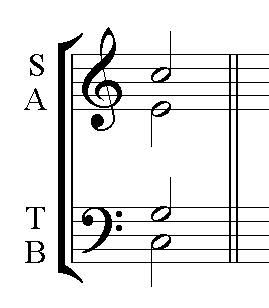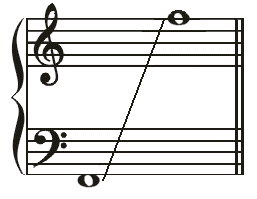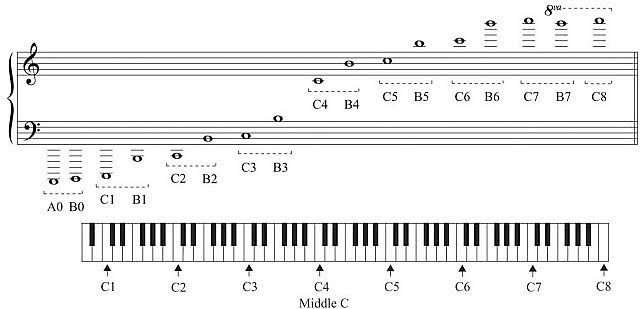If you’re new to singing or voice lessons, you may not know your voice type. Whether you like to sing opera or musical theatre or pop or jazz, it’s incredibly beneficial to know your voice type, as this will help you to find music that you know will be comfortable for you to sing and will flatter your voice.
 Your voice type (voice classification or voice part) is determined by two things: 1) the range of pitches you can sing and 2) the natural sound and feel of your voice. There are 6 main voice types: Soprano, Mezzo-Soprano, Alto, Tenor, Baritone, and Bass. While many pieces of music are arranged for Soprano, Alto, Tenor, and Bass voice parts only, vocalists are better classified as one of these 6 types. Of these categories, Soprano, Mezzo-Soprano, and Alto (Contralto) are traditionally female voices while Tenor, Baritone, and Bass are traditionally male voices. Your voice type changes drastically from childhood into adulthood, when it becomes relatively stable. So if you’re in your early 20s or younger, your voice type may still be changing.
Your voice type (voice classification or voice part) is determined by two things: 1) the range of pitches you can sing and 2) the natural sound and feel of your voice. There are 6 main voice types: Soprano, Mezzo-Soprano, Alto, Tenor, Baritone, and Bass. While many pieces of music are arranged for Soprano, Alto, Tenor, and Bass voice parts only, vocalists are better classified as one of these 6 types. Of these categories, Soprano, Mezzo-Soprano, and Alto (Contralto) are traditionally female voices while Tenor, Baritone, and Bass are traditionally male voices. Your voice type changes drastically from childhood into adulthood, when it becomes relatively stable. So if you’re in your early 20s or younger, your voice type may still be changing.
 Range
Range
The initial and most important determining factor for your voice type is your range. Your vocal range includes all the notes you can sing. It’s usually measured by what you’re comfortable singing, not what you can force out or squeak out at the top or bottom ends of your range. If you were to sing as high as you can and then as low as you can, you’d be hitting the top and bottom pitches in your range. The pitches you can sing are named according to the American Scientific Pitch Notation system, which I’ve explained in easy terms here.
Voice Sound, Quality, Feel
The second determining factor for your voice type is your sound, voice quality, and feel. Your voice has a unique sound or feel. In music, this can be called tone quality, timbre, or tone color. Your voice and tone color could be full, resonant, rich, light, nasal, hollow, husky, ethereal, plaintive, fluttery, piercing, sultry, sweet, powerful, bright, gravelly… there are so many different timbres! Every voice has a unique sound, and each voice type tends to have a different sound. For example, Beyoncé, Céline Dion, and Barbra Streisand are all female singers, but their voices sound quite different from each other. The same goes for male singers Freddie Mercury, Josh Groban, and Louis Armstrong.
How to Determine Your Voice Type
While you may be able to categorize your voice by its tone color, figuring out your vocal range may be difficult without the help of a skilled voice teacher. In my singing lessons, one of the first things I do with my students is analyze their vocal range to help them determine their voice type. Here are some of the basic classifications for each voice type, with name, range, and sound description.
Voice Types
Soprano – Range is from C4 to C6. Sopranos usually have a light, flexible voice, though many retain a full sound. Most female singers are sopranos. Examples: Sarah Brightman and Lea Salonga.
Mezzo-Soprano – A3 to A5. Mezzo-sopranos have a somewhat heavier, darker voice than sopranos, but not as heavy a tone as altos. Examples: Whitney Houston and Sara Bareilles.
Alto (Contralto) – F3 to F5. Alto singers tend to have a rich, heavy, full voice. Examples: Adele and Judy Garland.
Tenor – C3 to C5. Tenors have a light and flexible voice. Many male pop singers sing in tenor range, and it’s also the most common vocal part for men in musical theatre. Examples: Luciano Pavarotti and Michael Jackson.
Baritone – A2 to A4. Baritones tend to have a moderate, comfortable, creamy voice. Most male singers are baritones. Examples: Elvis Presley and Frank Sinatra.
Bass – E2 to E4. Bass voices tend to be rich, dark, full, and deeply resonant. Examples: Bing Crosby (Bass-Baritone) and Johnny Cash (also a Bass-Baritone).
Many singers have a wider or shorter range than shown here, and others have an unusual vocal tone for their range. Still, most voices have a distinct sound quality and comfortable singing range that classifies them primarily into one of these categories, even if they have a wider vocal range. For example, my vocal range is from about E3 to E6, but my voice timbre is soprano. My voice sounds and feels best when I’m singing soprano music.
Knowing your voice type will help you to find music that you can comfortably sing in your range and with your unique voice. If you’d like more help figuring out your voice type, widening your vocal range, or further developing your singing abilities, feel free to contact me for voice lessons. I work with all voice types.


